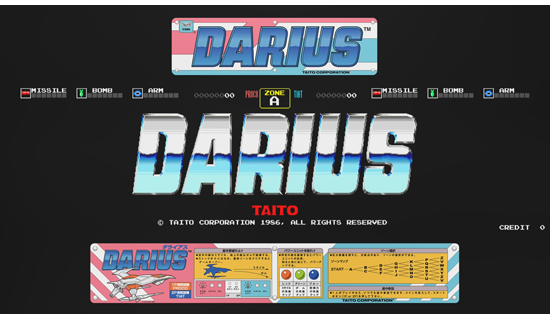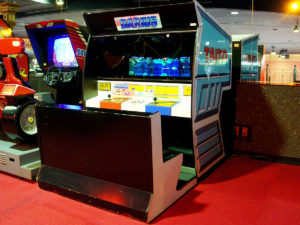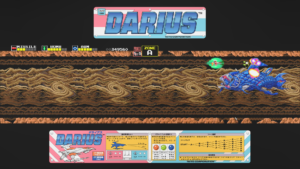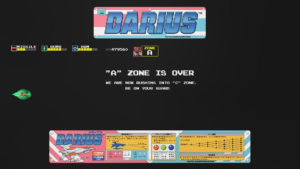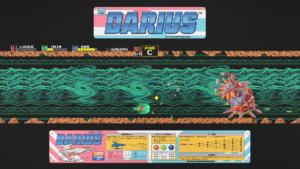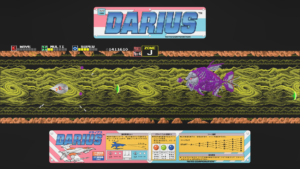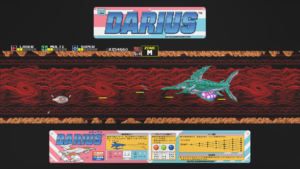Darius certainly wasn’t the first horizontally scrolling shooter, or probably even the first that comes to mind for most people. It wasn’t even the first shooter from developer/publisher Taito. But it was one of the most innovative, and that’s mostly because of the arcade hardware involved. Much like Taito’s own The Ninja Warriors one year later, Darius was housed in a sprawling setup: Three either 19 or 15 inch monitors (later the 15 inch version would be the only one still in production), a “body-sonic” seat with speakers beneath it to make the player really feel the music, and even a headphone jack (not a common feature on arcade games at this point). Even with modern arcade hardware, it’s very rare for a cabinet to be so focused on presenting both a superior audio and visual experience.
Being released a little less than two years after, it’s often compared to Konami’s Gradius. But other than being a side scrolling shooter (which often implies a certain degree of pattern memorization or observation, etc.), the two games don’t actually feel all that similar. They both share a similarly simple control scheme: A joystick and two buttons. One fires your standard guns, and the other fires bombs/missiles. Gradius pioneered the very well known power-up bar, which allows you to to customize how fast your ship moves and which weapons it fires as you collect power-ups. Darius certainly has power-ups to collect, but it all works in a very different way.
You can never change the speed of your ship’s movement, but there are three things you can change: Missiles (don’t get this confused with what Gradius calls missiles, here it just means your standard gun. You get just a single straight shot at first, but they eventually into lasers that go through enemies, and then waves that goes through walls), bombs (these are more like your Gradius missiles, where they fire down to hit enemies on the ground. Though when powered-up, they can eventually shoot out at all diagonal directions), and armor/shields (this is more or less the same thing that it is in Gradius). Each of these have their own meter that can be built up by collecting power-ups of that color (red for missiles, green for bombs, and blue for armor). You can collect about 7 of them before the bar actually goes up one level, and that’s when a change as to how that feature actually works occurs. When you die, you also won’t be completely de-powered: Instead you’ll be set back to the last level of power-up that you were at before dying. If you’d turned your standard missile into the laser, you’ll have the weakest version of the laser. So in theory, it makes sense to always be collecting every power-up you find to keep building your meters, without having to worry about a situation like when you’ve made your ship move TOO fast in Gradius. In theory that is…
Whereas in Gradius it sometimes makes sense to change your weapon up for different areas or bosses, or at the very least there’s one that can reasonably get you through most situations, Darius very much has a prescribed build that you should be using for best results. This is because when weapons completely change from one level to the next, they’re sometimes made not nearly as useful as they were just one power-up ago. The path to success lies in getting your missile up to just before it switches over to a new bar, so that you don’t go into the laser. It may sound cool, but it’s far too slow, and can’t cause nearly the amount of damage that the triple standard shots can. In fact in older versions of the game it would take significantly long amounts of time to beat the bosses with the laser or wave version of the weapon, though that would later be fixed. Bombs you definitely want to get up as high as you can, so that you’re constantly blasting death out in all directions. Shields you’ll need to be careful with too though, since maxing them out can actually increase your hit-box unnecessarily.
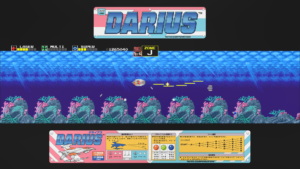
The biggest thing that sets Darius apart from Gradius though, is its aesthetic. The background environments certainly have more identity than most space shooters did, but the real draw is the bosses! Each end of stage boss is a robot that resembles some form of aquatic life, all with very…unique names and a very memorable entrance sequence. (“Warning!! A Huge Battle Ship (Name) Is Approaching Fast”). Each boss usually has at least a couple of different breakable parts, and additional enemies will come from off-screen to support them as the fight goes on longer, which is a good incentive to dispose of a boss as quickly as possible. They also seem very large and imposing for a game of that time, especially when compared to something like the Big Core from Gradius. The music (which we’ll get to later) was also very much composed to convey the presence of larger lifeforms.
Apparently there were a total of 13 bosses included at the version shown at the Japan Amusement Expo arcade show in October 1986 (where the prototype was first shown off), but of course the released version has only 11. Two of them were cut: Guard Savage (which was cut due to being too small of a boss character) and Big Rajarnn (which was cut due to being too slanted (I’m not sure exactly what this means…angular perhaps?)). The original plan was even to have a different boss for each stage in the branching path, but that obviously also didn’t happen. You’ll get the same boss no matter which path of a branch you choose. It won’t really be any different to fight, but the color will be different.
The other thing that the Darius series is known for that started right here, is its branching paths. You start in Zone A, and are given a choice of two branches to go down at the end of each level. In this case it means that there are 26 different stages in total, though many of them are quite similar to each other. Still, it means that you could play through the game a good amount of times without feeling like you’re having the exact same experience. The route you choose can even impact the ending. There’s even a map right there on the arcade cabinet, just below the monitor.
Also unlike Gradius, you can actually play two players simultaneously. However the number of power-up capsules doesn’t increase at all when you go into 2-player mode. Given that it takes long enough to get sufficiently powered-up with only one player, this means that a lot more planning is required as to who should be picking up what power-up. The two players will actually impede each other’s progress by running into the other ship as well. You won’t blow each other up, but it can make some bad situations. There’s even a change in the ending if you beat it with two players instead of one. The individual players even names: Player 1 is “PROCO”, and player 2 “TIAT”. If you put them together and read them backward, you get “TAITO CORP”. Apparently some of the minor enemies are even named are Taito employees at the time, when read backward: Tajifu becomes Fujita, Wa-Gaseha becomes Hasegawa, etc.
The music is also very much worth talking about. It was composed by former Zuntata member (and leader) Hisayoshi Ogura (aka OGR), and is maybe one of his more different soundtracks. It very much doesn’t follow the typical video game soundtrack template for that time, not being as obviously catchy as The Ninja Warriors was, and maybe makes for a bit of a difficult lesson on its own (though I think it works just fine within the game itself, as well as in the arranged versions). There were five different main pieces that are cycled throughout the various stages, in the different branching pathways. “Captain Neo” (the song that plays in all of the space levels) was actually a re-working of the title screen song from ground-based shooter “Metal Soldier Isaac II”, which was released in 1985 by Taito (based on “Metal Soldier Isaac” which was location tested in arcades in 1984, but never officially released). The original song was composed by Ogura as well, though he wasn’t yet an official employee of Taito at that time. According to Ogura he was only given one month to complete the music for the first Darius. So in order to have it ready for the Japan Amusement Expo arcade show, he hurriedly took that piece and converted it over into FM synth to include it in the prototype. Apparently it was so well liked there, that he just went ahead and left it as is for the released version. He talks a little bit more about composing Darius, The Ninja Warriors, and other things in this interview over at gaming.moe.
(Zuntata performing Captain Neo live during their first concert in 1990)
There were also two additional versions of the game that were released to arcades: New Version and Extra Version. The New Version introduced mostly just bug fixes: The issue in which bosses were much harder to defeat with the laser or wave was fixed. There was a graphical glitch at the end of the Y zone that was fixed as well. The “game over” font was also changed to red, which is actually the easiest way to identify if you’re playing either the Extra or New Version versus the old version. You can’t tell if you’re playing the New Version just by looking at the title screen, unlike Extra Version.
The Extra Version had quite a few more changes made to it, too many to list out individually. Boss health, the placement of enemies and items, shot strength, and just general difficulty of the game were all altered. Darius top-scorer Zenji Ishii of gaming magazine “Gamest” advised in terms of what should be changed in this version. You’ll actually see the words “Extra Version” next to the Darius logo on the title screen if you’re playing it, in small font just to the right.
I’m glad that we have both Gradius and Darius to choose from, but I think Darius is very much a series that gets better as it goes. This first entry just feels a little flat (despite its superior presentation) compared to what would come later, and honestly it throws a little bit too much at you without letting you do enough about it. I think Gradius’ power-up system is a better one, and as a game the first Gradius feels more manageable and less hectic (even though it certainly is still challenging). I felt myself getting better at the game little by little without a ton of practice, but without the ability to adjust the speed of my ship, I would hit a difficulty wall that I Just couldn’t break through around the 5th boss (Keen Bayonet). The amount of enemies on screen or the bullet patterns never come close to bullet hell levels of difficulty, but they’re just a bit too much for me with the speed that I have to work with. I really do appreciate the aesthetic that it brought (and continues to bring) to the genre though, and how daring it was with its avant-garde musical score. It’s just that when it comes to Darius, I’ll probably always go to one of the later entries in the series before this one.
The good news is that if you want a really great home port of the arcade version of Darius, Hamster has you covered with their Arcade Archives version on the PlayStation 4…as long as you can make a purchase from the Japanese PlayStation store, or pick up the extravagant 30th anniversary box that comes with a physical disc copy of the game, as well as an extensive soundtrack for a good chunk of the series. Like their port of The Ninja Warriors, it accurately captures the original three screen layout, and contains all three versions of the original game, along with Arcade Archives trademark Hi Score and Caravan modes.
If you’d rather play another port though, you have a good amount of choices. There were two separate PC Engine ports, both only released in Japan: Super Darius (on the PC Engine CD) and Darius Plus (just a standard HuCard, though it also was enhanced for play on the SuperGrafx). Both of these ports were also available on the Nintendo Wii Virtual console. PC Engine also featured the extremely limited (only 800 copies were ever produced) and now expensive Darius Alpha, which is basically just a boss-rush only version of the PC Engine port that was Darius Plus. Later on it would be ported to the Game Boy Advance as Darius R, and Japan saw what seems like a million different mobile phone ports of the game as well. As of 2017 you can even play it in a web browser as Darius The Origin, through Rakuten Games. The only two non-Japan only ports of the original would be Darius + (not to be confused with Darius Plus) for the Amiga, Atari ST, and ZX Spectrum in Europe. And these are very much more adaptations than they are ports, as they play quite a bit differently.
